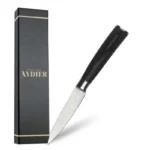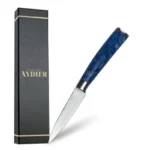Paring Knives

Paring Knives: A Small Knife with a Big Role in the Kitchen
A paring knife may be one of the smallest tools in your collection, but it is also one of the most essential. With a short blade that usually measures between 3 and 4 inches, this knife is designed for precision. It allows you to peel, trim, and shape fruits and vegetables with accuracy that larger knives, such as a chef’s knife or Santoku knife, cannot provide. In many kitchens, the paring knife becomes the go-to tool for everyday detail work.
Everyday Tasks Made Simple
Whereas a chef’s knife handles slicing and chopping on a cutting board, a paring knife shines when the work happens in your hand. From removing the eyes of a potato to deveining shrimp or coring strawberries, its sharp point and compact size give you control in delicate situations. Bakers often rely on it for segmenting citrus fruits or preparing garnishes, while home cooks use it for quick trimming when speed and precision matter.
Paring Knife vs. Utility Knife
Many people confuse the paring knife with the utility knife, as both are smaller than standard chef’s knives. The key difference lies in focus and control. A utility knife, with a slightly longer blade (often 5–6 inches), bridges the gap between small and large cutting tasks. In contrast, the paring knife is purpose-built for intricate work. Owning both ensures you can switch seamlessly between peeling an apple and slicing a sandwich.
Choosing the Right Size and Material
Most paring knives fall within the 3 to 4 inch range. A shorter blade, closer to 3 inches, gives maximum control for peeling and fine cuts. A slightly longer blade, around 4 inches, offers more versatility if you prefer a single knife for various small tasks. Blade material also plays a role. Stainless steel paring knives are durable and easy to maintain, while high-carbon steel options hold a sharper edge but may require more care. For those seeking aesthetics and performance, some brands even offer Damascus steel paring knives, combining layered design with strength.
Caring for Your Paring Knife
Because of its frequent use, a paring knife benefits from proper care. Hand washing and immediate drying prevent stains and keep the edge sharp. Storing it in a knife block, sheath, or magnetic strip protects the blade from unnecessary wear. Sharpening with a fine whetstone or professional sharpener ensures that the knife remains effective for delicate tasks. A well-maintained paring knife can last many years and become one of the most reliable tools in your kitchen.
A Must-Have for Precision Cutting
Every kitchen benefits from a paring knife, whether you are preparing a quick weekday meal or tackling more advanced recipes. Its compact size and sharp blade make it the perfect partner to larger knives like the chef’s knife or Santoku knife. Together, they create a balanced set that covers everything from heavy chopping to the most delicate details.

